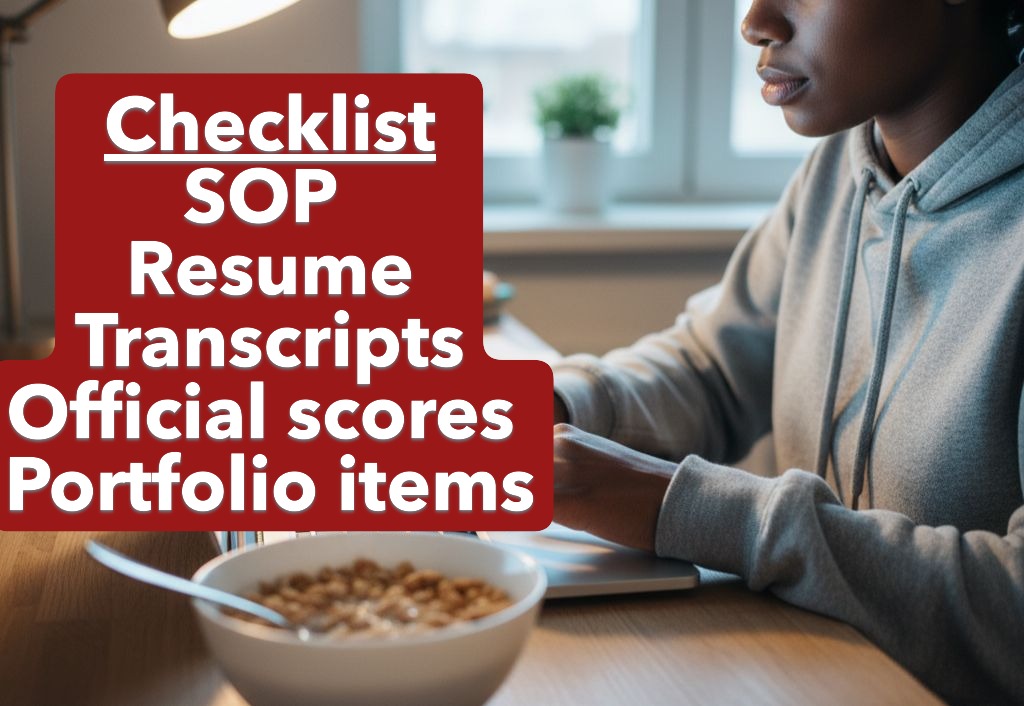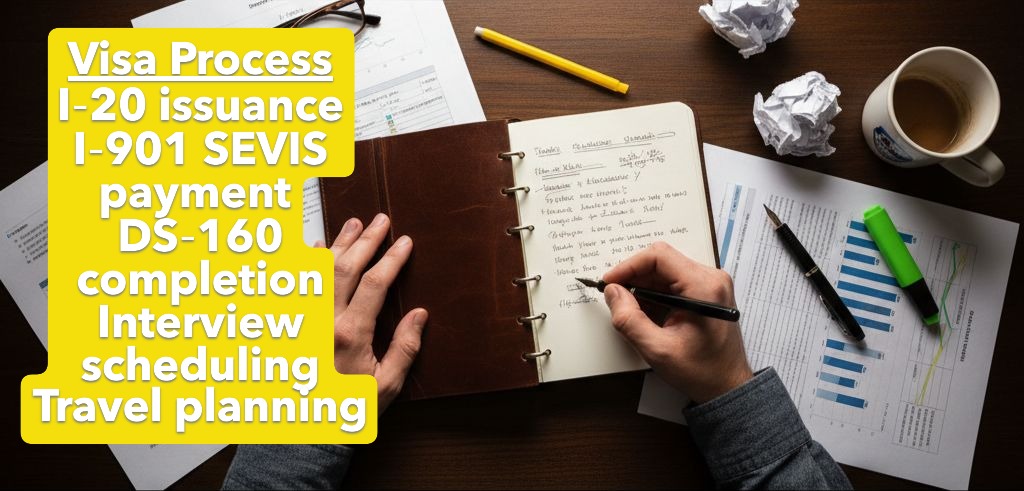How to Apply for a Master’s in the United States

A U.S. master’s application cycle runs 12–18 months from first shortlist to visa stamp. Each university sets its own deadlines, document rules, and funding windows, so the only way to stay ahead is to work from a structured checklist with built-in buffer time. Use this guide to map milestones, confirm eligibility, schedule tests, and prepare for the visa process without missing anything mission-critical.
Quick Steps (Overview)
- Confirm eligibility and build a master tracker (12–18 months out).
- Plan GRE/GMAT (if required) and English tests; line up recommenders (9–12 months).
- Draft SOPs, resumes, and supplemental materials; order transcripts (6–9 months).
- Submit applications early and monitor portals; follow up on recommendations (3–6 months).
- Compare offers and funding; request your I‑20/DS‑2019 (post‑admit).
- Pay SEVIS, book the F‑1 interview, and plan housing/arrival.
Quick FAQ: Three-year bachelor’s degree · GRE policy · Scholarship timing · Financial proof
Quick Snapshot
- Timeline anchors: shortlist programs 12–18 months out, test 9–12 months out, finalize documents 6–9 months out, submit 3–6 months out, then pivot to visa logistics post-admit.
- Most programs expect a four-year equivalent bachelor’s, GPA ≥3.0/4.0, and proof of English proficiency; prerequisites differ by department.
- Testing remains program-specific: verify each school’s GRE/GMAT and TOEFL/IELTS policies and allow for at least one retake window.
- There is no centralized portal—applications, fees, recommenders, and scholarships must be tracked per school. Browse more posts on the Blog or explore tag hubs like Masters, Admissions, and Visas.
- After acceptance, you must show funding, receive the Form I-20, pay the SEVIS fee, and secure an F-1 visa interview slot.
12–18 Months Before Enrollment: Confirm Eligibility and Build Your Tracker
- Verify that your bachelor’s degree is equivalent to a four-year U.S. credential; many institutions accept certain three-year degrees once evaluated by services like WES, but policies differ.
- Aim for at least a 3.0/4.0 GPA (roughly a “B” average). Flag upper-level courses in your target discipline; selective programs may expect higher subject GPAs.
- Audit prerequisite coverage. If you are pivoting fields, identify bridge or leveling courses now so transcripts reflect them before you apply.
- Build a long list using EducationUSA’s five-step framework, departmental pages, and professional rankings. Track curriculum focus, faculty fit, assistantship odds, cost of attendance, and intake options (fall vs. spring).
- Spin up a spreadsheet or Notion tracker with columns for deadlines, writing prompts, recommenders, test codes, funding essays, and post-submission tasks. Scholarship deadlines often precede application deadlines by several weeks.
9–12 Months Before Enrollment: Lock Testing and Recommenders
- Confirm each program’s standardized testing stance. Even where the GRE is optional, STEM, analytics, and business programs may still expect scores strong enough to reinforce your academic profile. Register early through ETS or GMAC.
- Confirm each program’s standardized testing stance. Even where the GRE is optional, STEM, analytics, and business programs may still expect scores strong enough to reinforce your academic profile. Register early through ETS (GRE) or GMAC (GMAT).
- International applicants typically submit recent TOEFL, IELTS, or Duolingo English Test scores. Check minimums and score-reporting codes directly on graduate admissions pages; for example, UC Berkeley’s Graduate Division outlines exemptions and acceptable exams.
- Official exam sites: TOEFL by ETS, IELTS, and Duolingo English Test.
- Reserve test dates with room for at least one retake before priority deadlines.
- Confirm two to three recommenders (faculty, supervisors) who can speak to your readiness for graduate-level work. Provide them with your CV, transcripts, draft statement of purpose, and bullet notes on projects they oversaw.
- Keep a rolling reminder schedule so recommenders see deadlines at 6, 4, and 2 weeks out.
6–9 Months Before Enrollment: Produce Application Materials
- Draft a tailored statement of purpose for each institution. Explain your preparation, research or professional goals, and strong program fit. Reference specific labs, faculty, courses, or partnerships—outdated or generic names are a credibility red flag.
- Refine your resume into a one- to two-page document featuring quantifiable outcomes, major projects, research outputs, and leadership that aligns with your program goals.
- Prepare supplemental materials (writing samples, portfolios, coding challenges) per the formatting and length rules listed by each department.
- Order unofficial transcripts for application uploads, and line up certified translations if needed. Know how to request sealed official copies quickly after admission decisions.
- Organize official score reports in your tracker with institution codes, test dates, and submission confirmations.

3–6 Months Before Enrollment: Submit and Monitor
- Complete each university’s application portal—there is no Common App for U.S. master’s programs, so expect unique interfaces, document requirements, and application fees (USD 75–120 in most cases). Submit fee waiver requests early if you qualify.
- Audit each section before payment: recommender emails, transcript uploads, scholarships, assistantships, and optional diversity or funding essays.
- Hit “submit” several days before posted deadlines to avoid time-zone surprises or portal outages.
- Confirm submissions via email receipts and portal dashboards. Follow up with recommenders if any letters remain outstanding.
- Respond promptly to departmental requests for interviews, writing prompts, additional financial proof, or portfolio revisions.
After Admission: Funding, Visa, and Arrival Logistics
- Compare offers by mid-April (many funded offers follow the April 15 Council of Graduate Schools deadline). Evaluate tuition, living costs, assistantships, fellowships, and work authorization policies.
- See the Council of Graduate Schools April 15 Resolution for common funded-offer reply expectations.
- Accept your preferred offer, submit the enrollment deposit if required, and confirm any funding contracts in writing.
- Provide financial documentation (bank statements, sponsor letters, scholarship awards) so the university can issue your Form I-20 or DS-2019. Guidance typically lives in your admit portal and on the international office pages—see, for example, NYU’s proof of funding checklist.
- Pay the I-901 SEVIS fee, complete the DS-160, and schedule your F-1 visa interview via U.S. Department of State. Interview wait times fluctuate, so check the embassy or consulate calendar weekly.
- Official resources: I‑901 SEVIS Fee Payment, Form DS‑160 overview (see DS‑160), and Visa Appointment Wait Times.
- Arrange housing, health insurance, immunization records, and arrival travel. Most campuses run mandatory international orientation in the weeks leading up to classes—arrive early enough to finalize paperwork and settle in. For more visa‑specific guidance, see all Visa posts.

What Makes U.S. Master’s Admissions Different
- Holistic review: Committees weigh GPA, test scores, writing, experience, and program fit—no single metric guarantees admission or rejection.
- Program-specific rules: Requirements vary even within the same university. Maintain a tracking sheet so you never extrapolate one department’s policy to another.
- Funding is competitive: Assistantships and scholarships for master’s students are often limited and may require separate forms or earlier deadlines. Begin funding research alongside your program shortlist.
- Few conditional offers: Most programs expect completed bachelor’s requirements and English benchmarks before enrollment, though pathway or ESL bridging options exist at some schools.
Quick Checklist
- Confirm eligibility, GPA, and prerequisite coverage; create your master tracker.
- Shortlist programs 12–18 months out and log deadlines, essays, and funding forms.
- Register for GRE/GMAT (if required) and TOEFL/IELTS/Duolingo; leave retake buffers.
- Lock recommender commitments and build SOPs, resumes, and supplemental materials.
- Submit applications early, monitor portals, and respond quickly to follow-up requests.
- Post-admit, finalize funding, request the I-20, secure the F-1 visa, and plan your move.
FAQ
Will U.S. universities accept my three-year bachelor’s degree?
Many do, especially if a credential evaluation service deems it equivalent to a four-year U.S. degree or if the institution has standing agreements with your university. Always confirm on the graduate admissions page or by emailing the department. If a program does not accept three-year degrees, you may need to complete a postgraduate diploma or one-year bridge program first.
Is the GRE mandatory for master’s admission?
Not universally. Numerous programs have moved to GRE-optional policies, but some STEM, business, analytics, and quantitative social science tracks still expect scores. Treat each program’s instructions as definitive: if they say “required,” plan to test; if they say “optional,” submit a strong score only when it elevates your profile.
When should I apply for scholarships or assistantships?
Start as soon as you finalize your shortlist. Many scholarships close months before admission deadlines, and assistantship sections are often embedded inside the main application. Track funding essays or supplemental forms alongside program deadlines so you never miss early windows.
Do I need financial proof before I receive an admission offer?
Financial documentation is usually required after admission so the school can issue your I-20 or DS-2019. That said, gather statements, affidavits, and translations early—currency conversions and official letters take time, and some programs request proof of funds during review when they’re considering you for scholarships.
Sources & Further Reading
- EducationUSA: Your 5 Steps to U.S. Study
- U.S. Department of State: Student Visa (F-1) Overview
- ETS: GRE General Test Registration
- ETS: Sending TOEFL Scores
- ETS: TOEFL Home
- IELTS: Register for IELTS
- Duolingo English Test: Official Site
- GMAC: GMAT Exam
- UC Berkeley Graduate Division: International Applicant Requirements
- New York University: Proof of Funding Instructions
- Council of Graduate Schools: April 15 Resolution
- Department of Homeland Security: I‑901 SEVIS Fee
- U.S. Department of State: Visa Appointment Wait Times
Related posts
- Secret Time Saver: 7 Proven ChatGPT Task Automations for Master’s & PhD Success
Seven copy-paste ChatGPT Task templates that automate lit sweeps, advisor prep, funding scans, writing sprints, reminders, and more for Master's & PhD students.
- 10 'Secret' ChatGPT Prompting Methods for Post-Grad Students
Transform your academic writing and research with these 10 field-tested ChatGPT prompting techniques designed specifically for master's and PhD applicants.
- 25 Most Prestigious Universities in US
Ever wondered what the top 25 most prestigious US universities are? In this post we share a list and how the ranking works